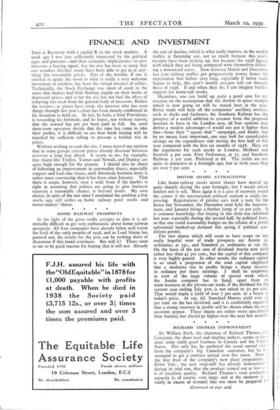HOME RAILWAY PROSPECTS
In the light of the gross traffic receipts to date it is ad- mittedly difficult to get very enthusiastic about home railway prospects. All four companies have already fallen well below the level of the early months of 1938, and as Lord Stamp has pointed out, the results for the year can be nothing short of disastrous if this trend continues. But will it? There seem to me to be good reasons for hoping that it will not. Already the rate of decline, which is what really matters, in the weekly traffics is flattening out, not so much because this year's receipts have been picking up, but because the 1938 figures with which they are being compared were themselves follow- ing a downward curve. Now between March and December last year railway traffics got progressively worse; hence the expectation that before very long, especially if better trade begins to help, this year's weekly receipts will cut through those of 1938. If and when they do, I can imagine further support for home-rail stocks.
Meantime, one can build up quite a good case for net revenue on the assumption that the decline in gross receipts which is now going on will be erased later in the year. Better trade will help all the companies' ancillary services, such as docks and harbours, the Southern Railway has the prospect of a useful addition to revenue from the proposed increase in fares in the London area, all four systems may derive a modest advantage—I would not put it higher than that—from their "square deal" campaign, and finally, but by no means least important, one may look for considerable savings on the expenditure side during the first half of this year compared with the first six months of 1938. Here are the arguments for such stocks as London, Midland and Scottish 4 per cent. First Preference, at 55, and Southern Railway 5 per cent. Preferred at 68. The yields are not quite so attractive as a fortnight ago, but in both cases they are over 7 per cent.










































 Previous page
Previous page